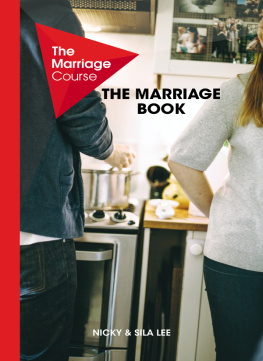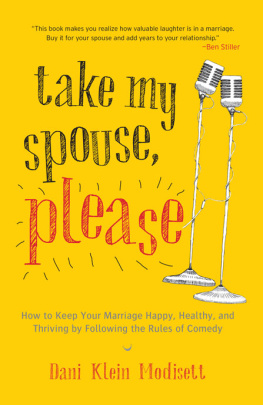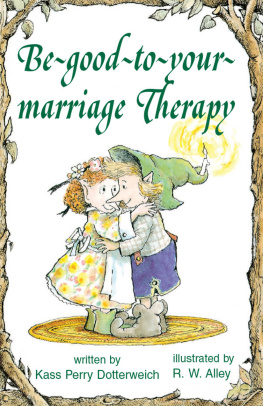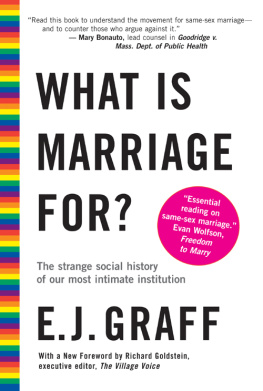MARRIAGE RULES
BY THE AUTHOR
Marriage Rules
The Dance of Fear
The Dance of Connection
The Mother Dance
Life Preservers
The Dance of Deception
The Dance of Intimacy
The Dance of Anger
Women in Therapy
Franny B. Kranny, Theres a Bird in Your Hair!
(with Susan Goldhor)
Whats So Terrible About Swallowing an Apple Seed?
(with Susan Goldhor)
MARRIAGE RULES

A Manual for the Married
and the Coupled Up
HARRIET
LERNER, PH.D.

Gotham Books
GOTHAM BOOKS
Published by Penguin Group (USA) Inc.
375 Hudson Street, New York, New York 10014, U.S.A.
Penguin Group (Canada), 90 Eglinton Avenue East, Suite 700, Toronto, Ontario M4P 2Y3, Canada (a division of Pearson Penguin Canada Inc.); Penguin Books Ltd, 80 Strand, London WC2R 0RL, England; Penguin Ireland, 25 St. Stephens Green, Dublin 2, Ireland (a division of Penguin Books Ltd); Penguin Group (Australia), 250 Camberwell Road, Camberwell, Victoria 3124, Australia (a division of Pearson Australia Group Pty Ltd); Penguin Books India Pvt Ltd, 11 Community Centre, Panchsheel Park, New Delhi110 017, India; Penguin Group (NZ), 67 Apollo Drive, Rosedale, Auckland 0632, New Zealand (a division of Pearson New Zealand Ltd); Penguin Books (South Africa) (Pty) Ltd, 24 Sturdee Avenue, Rosebank, Johannesburg 2196, South Africa
Penguin Books Ltd, Registered Offices: 80 Strand, London WC2R 0RL, England
Published by Gotham Books, a member of Penguin Group (USA) Inc.
First printing, January 2012
10 9 8 7 6 5 4 3 2 1
Copyright 2012 by Harriet Lerner
All rights reserved
Gotham Books and the skyscraper logo are trademarks of Penguin Group (USA) Inc.
LIBRARY OF CONGRESS CATALOGING-IN-PUBLICATION DATA
Lerner, Harriet Goldhor.
Marriage rules : a manual for the married and the coupled up / Harriet Lerner.
p. cm.
EISBN: 9781101554210
1. Married peoplePsychology. 2. CouplesPsychology. 3. MarriagePsychological aspects. 4. Marital quality. I. Title.
HQ734.L394 2012
306.872dc23
2011032928
Printed in the United States of America
Set in Adobe Garamond Pro
Designed by Spring Hoteling
Without limiting the rights under copyright reserved above, no part of this publication may be reproduced, stored in or introduced into a retrieval system, or transmitted, in any form, or by any means (electronic, mechanical, photocopying, recording, or otherwise), without the prior written permission of both the copyright owner and the above publisher of this book.
The scanning, uploading, and distribution of this book via the Internet or via any other means without the permission of the publisher is illegal and punishable by law. Please purchase only authorized electronic editions, and do not participate in or encourage electronic piracy of copyrighted materials. Your support of the authors rights is appreciated.
While the author has made every effort to provide accurate telephone numbers and Internet addresses at the time of publication, neither the publisher nor the author assumes any responsibility for errors, or for changes that occur after publication. Further, the publisher does not have any control over and does not assume any responsibility for author or third-party websites or their content.
To Betty Carter and Monica McGoldrick,
brilliant pioneers in the field of family theory and therapy
AUTHORS NOTE
This book is inspired by Michael Pollans slender volume about healthful eating called Food Rules, an eaters guide meant to bring much-needed simplicity to our daily decisions about food. Dont eat breakfast cereals that change the color of the milk, Pollan advises, and Dont eat anything your great-grandmother wouldnt recognize as food. His rules are all one needs to know to eat wisely and well. Eating, Pollan demonstrates, doesnt have to be so complicated.
Neither does marriage, I thought to myself while thumbing through his book. Why not a book about marriage (defined loosely as couples in a long-term commitment) for those who want just the rules, without the theory behind them? Admittedly, coupling up is more complicated than eating, but I decided it wouldnt be all that difficult to lay out one hundred concise rules that make a relationship work, or at least give it the best chance of succeeding.
I am grateful to Michael Pollan for reminding me that keeping things simple is often the best way to teach the most complicated things.
INTRODUCTION
IT SHOULDNT BE THAT COMPLICATED
People spend their hard-earned money seeking the advice of relationship experts when they already know what they need to do to have a good marriageor at least a better one. I was recently reminded of this fact when listening to the marriage vows that two young people said out loud to each other in front of their community of family and friends.
They said in turn:
I promise to always treat you with kindness and respect.
I promise to be faithful, honest, and fair.
I promise to listen carefully to what you are saying.
I promise to apologize when I am wrong and to repair any harm I have done.
I promise to cook and clean for you.
I promise to be your partner and best friend in the best and worst of times.
I promise to bring my best self into our relationship.
I promise to live these promises as a daily practice.
How do you think this couple came up with their shared promises? Did they plow through the countless self-help books and blogs about the how-tos of a successful relationship? Did they consult the work of psychologists and marriage counselors and study the latest research on marital failure and success?
Of course not. They consulted their own hearts, their core values, their life experience, and the Golden Rule. By the time were old enough to choose a life partner, weve observed a number of marriages and have a pretty good idea about what makes things better and worse. We know its usually a good idea to treat the other person as wed like to be treated.
If this couple lives their promises as a daily practice (even with a large margin of error), their marriage will do very well, indeed. Need the experts say more?
OK, ITS NOT THAT SIMPLE
With marriage having a 50 percent no-go rate, its obvious that people dont follow their promises, or their best thinking, just like people dont eat healthfully even when they know whats good for them. Paradoxically, its in our most enduring and important relationships that were least likely to be our most mature and thoughtful selves.
Real life is messy and complicated. When we share a living space with another person, tie our finances together, negotiate sexuality and the countless decisions that daily life demandswell, of course things can go badly. Then theres the baggage we bring from our first family, and all the unresolved issues of the past, to say nothing of all the stresses that pile up as we move along the life cycle. If we make or adopt a baby (never mind adding stepchildren to the picture), its more difficult still because nothing is harder on a marriage than the addition or subtraction of a family member. In fact, it amazes me that all marriages dont fly apart by the babys first birthday.
THE FIGHT-OR-FLIGHT RESPONSE
The older I get, the more humble I am about marriage. When anxiety spirals high enough, and lasts long enough, even the most mature relationship may begin to look like a dysfunctional one. To paraphrase the novelist Mary Karr, a dysfunctional marriage is any marriage that has more than one person in it.
Next page
















